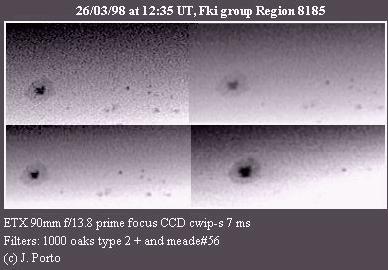More on Solar Observing
Jack Kramer
Since the time I wrote an earlier article on methods of observing the sun, I've picked up some additional pointers that you may find useful.
Telescope Size
A small telescope is perfectly fine for solar observing because the sun's brightness makes light grasp a non-issue. Observing reports from the SOLNET group include info on the instruments used; usually the telescopes are relatively small. Three and four-inch refractors and small catadioptric scopes are quite common. For example, the following images were taken through a 90mm Meade ETX Maksutov-Cassegrain telescope by Joao Porto of the Azores.

But it turns out there's another reason for this beyond the ample light available from the sun. In the Astronomical League publication Observe and Understand the Sun, the following is noted:
Daytime seeing is never as good as nighttime seeing because of solar heating. In fact, at the best sites, one arc second seeing is experienced only 1% of the time! For amateur astronomers this figure is probably too generous as we usually cannot choose our observing sites. So, rarely, if ever, will a daytime aperture of over 4 inches be useful.
When observing conditions are poor, a small telescope will be a superior performer because a large scope is looking through a correspondingly larger column of air. Another solution for owners of larger telescopes is to use an off-axis diaphragm and a solar aperture filter. (The details were included in the article on the Sun in the August 1997 issue of NightTimes; that article is also available on our web site.) This leads to the next point...
When to Observe
One point frequently noted is that daytime heating of the air increases the instability of the atmosphere. This is apparent when you look at the limb of the sun through a telescope. It usually seems to be seething and boiling. That's not the sun itself, but an artifact of our atmosphere. Accordingly, the recommended time of observation is before noon, since the atmospheric heating (and unsteadiness) has not yet reached its peak.
Filters
The preferred method of observation is with a solar filter in front of the telescope optics. I had not been able to detect an appreciable difference between the images with a coated mylar filter and with a glass filter, but this was not based on a careful side-by-side comparison on the same telescope. Further reading has shown that there is a marked preference among active solar observers in favor of glass filters, such as those supplied by Thousand Oaks Optical. The reason for this is that mylar filters transmit in the blue range of the spectrum where the human eye is less sensitive. As a result, fine details can be lost. In addition, blue light is more prone to atmospheric scattering, so only under the best possible conditions will a blue light image approach the detail available with a yellow-to-orange image presented by coated glass filters. If you already have a mylar filter, the addition of a yellow filter on your eyepiece will somewhat improve the view by absorbing the blue range of the spectrum.
****
With the increase in solar activity during the current (1998) sunspot cycle, now is the time to observe our local star. As you can see, there's nothing terribly exotic about the equipment needed for basic observing.
Published in the August 1998 issue of the NightTimes




